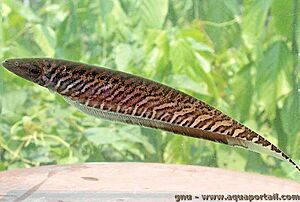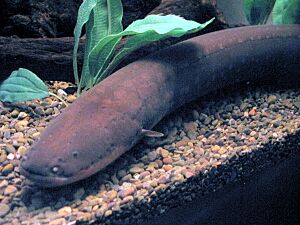Naked-back knifefish facts for kids
Quick facts for kids Naked-back knifefish |
|
|---|---|
 |
|
| Banded knifefish (Gymnotus carapo) | |
 |
|
| Electric eel, Electrophorus electricus | |
| Scientific classification |
|
| Kingdom: | Animalia |
| Phylum: | Chordata |
| Class: | Actinopterygii |
| Order: | Gymnotiformes |
| Suborder: | Gymnotoidei |
| Family: | Gymnotidae Rafinesque, 1815 |
| Genera | |
|
see text |
|
The naked-back knifefishes are a unique family of fish called Gymnotidae. These fascinating ray-finned fishes live only in the fresh waters of Central America and South America. What makes them truly special is their ability to sense and even create electricity! They use these special organs for electroreception. There are about 43 known species in this family, divided into two main groups. These fish are mostly active at night (nocturnal) and prefer calm waters, like deep rivers or swamps. If the water flows too fast, they might even bury themselves in the mud.
Contents
Amazing Electric Fish: Naked-back Knifefishes
Naked-back knifefishes are known for their unusual bodies and incredible electric powers. They are a great example of how animals adapt to their environment in amazing ways.
What Do They Look Like?
Like other knifefishes, members of the Gymnotidae family have long, sleek bodies that look a bit like an eel. They do not have a dorsal fin (the fin on their back) or pelvic fins (the fins usually found on their belly). Instead, they have an extremely long anal fin, which runs almost the entire length of their underside. This long fin is very flexible and helps them move through the water with wavy motions, allowing them to swim forward and backward with ease.
How Do They Use Electricity?
All knifefishes in this family have special organs that help them sense electricity. Some, like the famous Electric eel from the genus Electrophorus, can even generate powerful electric shocks! The electric eel is the largest of these fish, growing over 2 meters (about 6.5 feet) long. It can produce strong electric discharges, up to 600 volts, to stun its prey.
But that's not all! Electric eels also create weak electric signals, less than 1 volt. They use these weaker signals for communication with other fish and for navigating their surroundings. Since many knifefishes have limited vision, these electric fields act like a "sixth sense." They help the fish "see" in dark or murky waters, find food, and avoid obstacles.
Different Kinds of Knifefishes
Scientists have identified about 43 valid species within the Gymnotidae family. These species are grouped into two main categories, or genera:
- The genus Electrophorus includes the three species of electric eels. These are the largest and most powerful electric fish.
- The genus Gymnotus contains about 40 species, often called banded knifefishes. These fish are generally smaller, ranging from about 10 to 100 centimeters (about 4 inches to 3 feet) in length.
Scientists continue to study these amazing creatures to learn more about their unique electric abilities and how they live in their freshwater homes.

